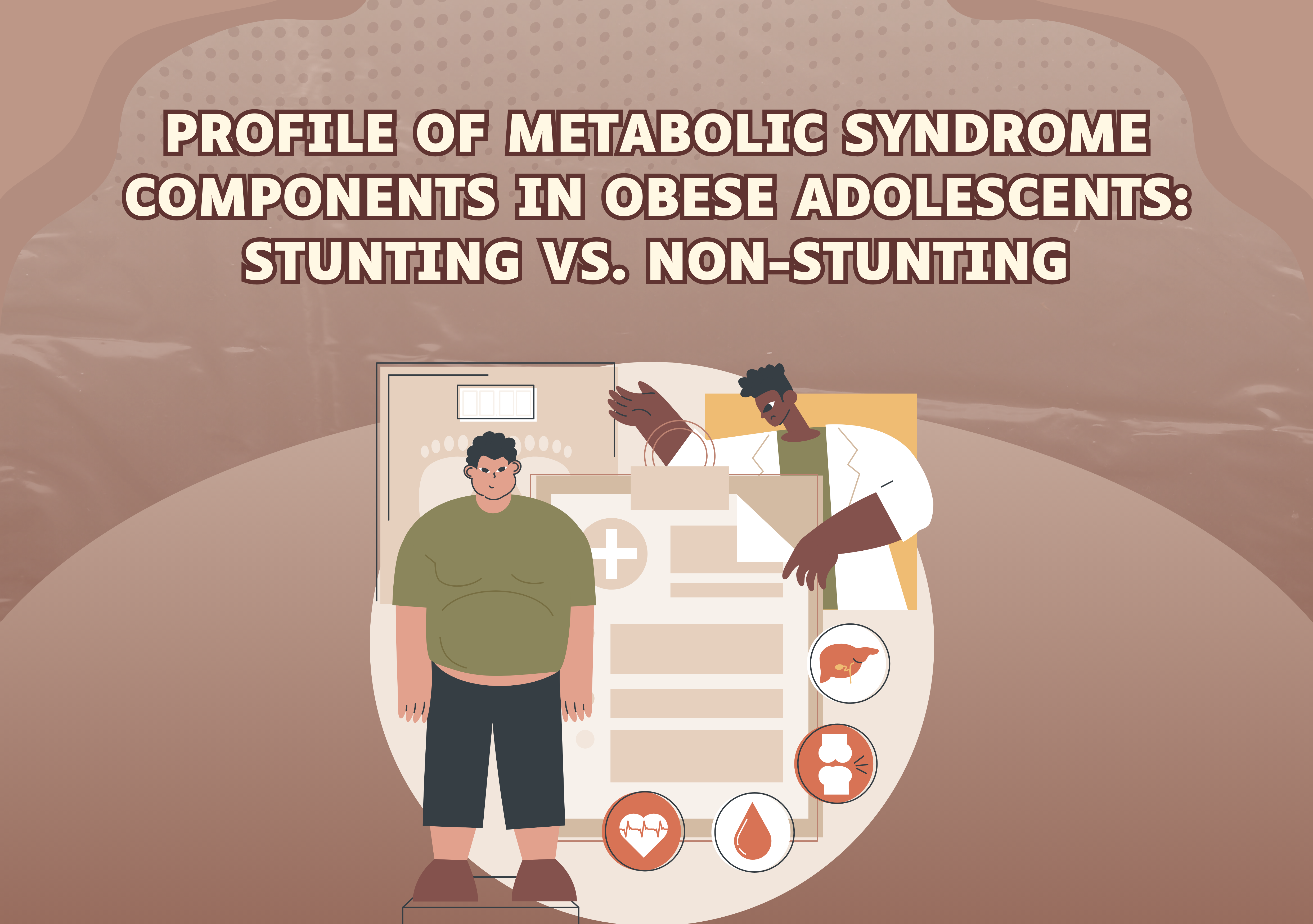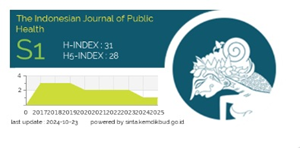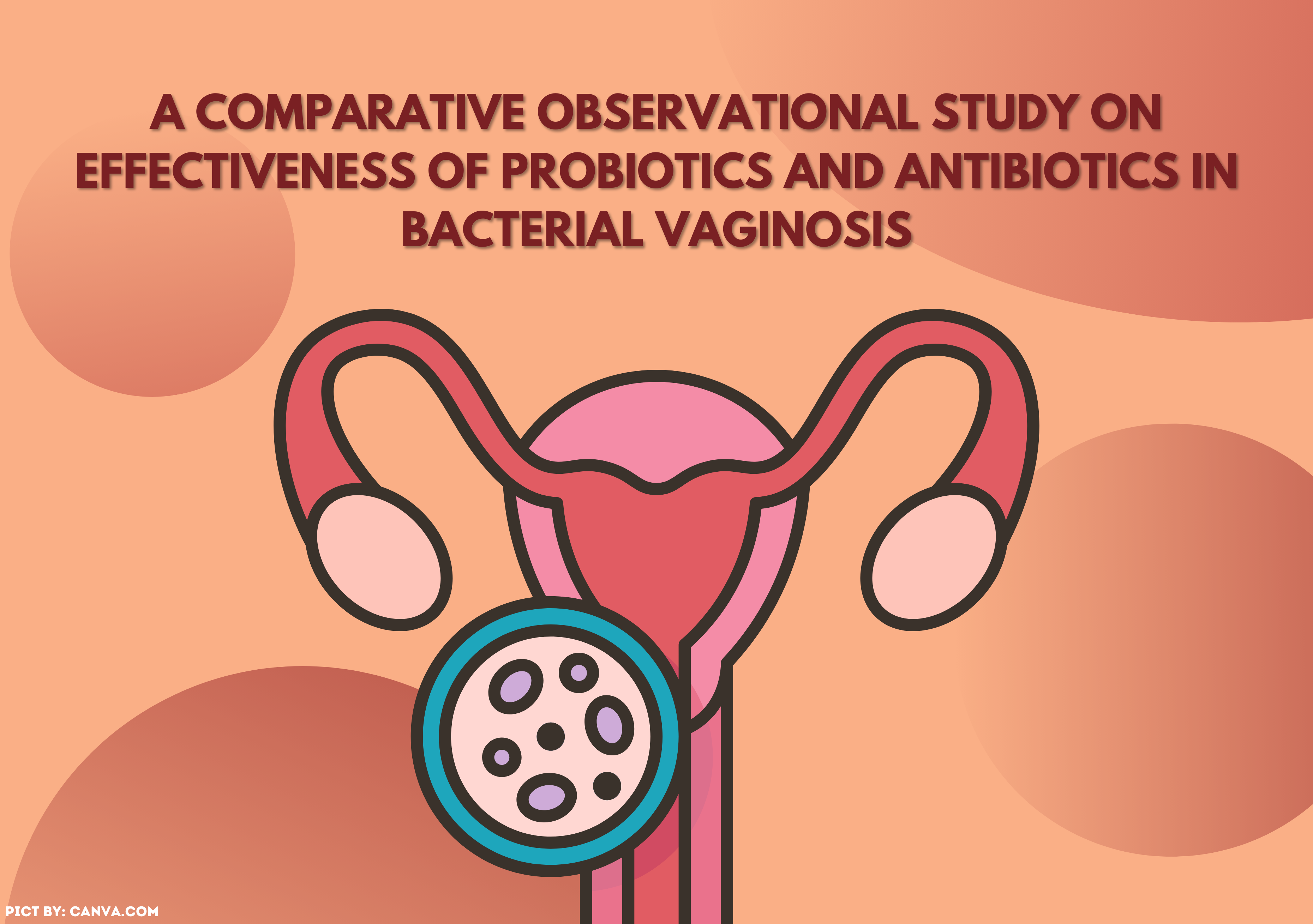PROFILE OF METABOLIC SYNDROME COMPONENTS IN OBESE ADOLESCENTS: STUNTING VS. NON-STUNTING

Introduction: Stunted children are more likely to become obese, with a prevalence of 1.33% in children under the age of five. Aims: To evaluate the metabolic syndrome (MetS) profile in overweight/obese adolescents who are either stunted or not, and to determine the associations between stunting characteristics (height-for-age z-score, or HAZ) and anthropometric measurements (waist circumference, hip circumference, and waist-to-hip ratio), as well as MetS indicators. Methods: A retrospective observational study was conducted focusing on adolescents who were overweight or obese. Subjects were divided into 2 groups based on height-for-age z-score (HAZ): stunting group and non-stunting group. Subject numbers were determined by total sampling due to the number of stunted being small. Results: The prevalence of MetS in stunting overweight/ obese adolescents was 18.75%, dominated by female. There was a significant difference on BMI (34.60 (26.80-45.09) vs. 31.11 (27.34-40.13, p=0.040), waist-to-height ratio (0.63 (0.54-0.73) vs. 0.58 (0.52-0.64), p=0.005), hip circumference (111.27 (95-135) vs. 102.50 (87-114) cm, p=0.012) and systole blood pressure (124.37 (110-140) vs. 116.25 (100-130) mmHg, p=0.032), greater in stunting subjects than non-stunting. Waist-to-hip ratio was lower in stunting than non-stunting (0.85 (0.69-0.97) vs. 0.92 (0.81-0.99), p=0.012). HAZ was correlated negatively with BMI (r=-0.358, p=0.044), but correlated positively with hip circumference (r=0.215, p=0.023). Conclusion: Adolescents who were stunted and overweight/obese exhibited higher values for BMI, waist-to-height ratio, hip circumference, and systolic blood pressure compared to non-stunted individuals who were overweight/obese. There was a correlation between the height-for-age z-score and both BMI and waist-to-hip ratio.
Al-Taiar, A., Alqaoud, N., Sharaf Alddin, R., Alanezi, F., Subhakaran, M., Dumadag, A., Albatineh, A.N., 2021. Stunting and Combined Overweight with Stunting among Schoolchildren in Kuwait: Trends over a 13-Year Period. Med. Princ. Pract. 30, 515–521. https://doi.org/10.1159/000518533
Bacopoulou, F., Efthymiou, V., Landis, G., Rentoumis, A., Chrousos, G.P., 2015. Waist circumference, waist-to-hip ratio and waist-to-height ratio reference percentiles for abdominal obesity among Greek adolescents. BMC Pediatr. 15, 1–9. https://doi.org/10.1186/s12887-015-0366-z
Baker, J.L., Olsen, L.W., Sørensen, T.I.A., 2007. Childhood Body-Mass Index and the Risk of Coronary Heart Disease in Adulthood. N. Engl. J. Med. 357, 2329–2337. https://doi.org/10.1056/NEJMoa072515
Bénéfice, E., Garnier, D., Simondon, K.B., Malina, R.M., 2001. Relationship between stunting in infancy and growth and fat distribution during adolescence in Senegalese girls. Eur. J. Clin. Nutr. 55, 50–58. https://doi.org/10.1038/sj.ejcn.1601121
Clemente, A.P.G., Santos, C.D.D.L., Martins, V.J.B., Albuquerque, M.P., Fachim, M.B., Sawaya, A.L., 2014. Lower waist circumference in mildly-stunted adolescents is associated with elevated insulin concentration. J. Pediatr. (Rio. J). 90, 479–485. https://doi.org/10.1016/j.jped.2014.01.015
Das Gupta, R., Haider, S.S., Hashan, M.R., Rahman, M.A., Sarker, M., 2019. Association between height and hypertension in the adult Nepalese population: Findings from a nationally representative survey. Heal. Sci. Reports 2, 1–7. https://doi.org/10.1002/hsr2.141
de Onis, M., Branca, F., 2016. Childhood stunting: A global perspective. Matern. Child Nutr. 12, 12–26. https://doi.org/10.1111/mcn.12231
Dyer, A.R., Elliott, P., Shipley, M., 1990. Body Mass Index versus Height and Weight in Relation to Blood Pressure. Am. J. Epidemiol. 131, 589–596. https://doi.org/10.1093/oxfordjournals.aje.a115543
Emerging Risk Factors Collaboration, 2012. Adult height and the risk of cause-specific death and vascular morbidity in 1 million people: Individual participant meta-analysis. Int. J. Epidemiol. 41, 1419–1433. https://doi.org/10.1093/ije/dys086
Eriksson, J.G., Forsén, T., Tuomilehto, J., Osmond, C., Barker, D.J.P., 2003. Early adiposity rebound in childhood and risk of Type 2 diabetes in adult life. Diabetologia 46, 190–194. https://doi.org/10.1007/s00125-002-1012-5
Fahed, G., Aoun, L., Zerdan, Morgan Bou, Allam, S., Zerdan, Maroun Bou, Bouferraa, Y., Assi, H.I., 2022. Metabolic Syndrome: Updates on Pathophysiology and Management in 2021. Int. J. Mol. Sci. 23. https://doi.org/10.3390/ijms23020786
Fayasari, A., Huriyati, E., Julia, M., 2019. Body Composition of Adolescent of Shorter Stature. Pakistan J. Nutr. 18, 711–715. https://doi.org/10.3923/pjn.2019.711.715
Fernald, L.C., Neufeld, L.M., 2007. Overweight with concurrent stunting in very young children from rural Mexico: Prevalence and associated factors. Eur. J. Clin. Nutr. 61, 623–632. https://doi.org/10.1038/sj.ejcn.1602558
Gavin, K.M., Bessesen, D.H., 2020. Sex Differences in Adipose Tissue Function. Endocrinol Metab Clin North Am 49, 215–228. https://doi.org/10.1016/j.ecl.2020.02.008
Grillo, L.P., Gigante, D.P., Horta, B.L., De Barros, F.C.F., 2016. Childhood stunting and the metabolic syndrome components in young adults from a Brazilian birth cohort study. Eur. J. Clin. Nutr. 70, 548–553. https://doi.org/10.1038/ejcn.2015.220
Güngör, N.K., 2014. Overweight and obesity in children and adolescents. JCRPE J. Clin. Res. Pediatr. Endocrinol. 6, 129–143. https://doi.org/10.4274/jcrpe.1471 1
Hammoda, A.., El Sallamy, R., Atlam, S.-E., Alshishtawy, M., 2022. A study of risk factors contributing to the occurrence of excess weight with concurrent stunting in preschool children in Egypt. Tanta Med. J. 50, 48. https://doi.org/10.4103/tmj.tmj_118_21
Henriques, A., Teixeira, V., Cardoso, H.F.V., Azevedo, A., 2018. The influence of stunting on obesity in adulthood: Results from the EPIPorto cohort. Public Health Nutr. 21, 1819–1826. https://doi.org/10.1017/S1368980018000460
Hoffman, D.J., Sawaya, A.L., Verreschi, I., Tucker, K.L., Roberts, S.B., 2000. Why are nutritionally stunted children at increased risk of obesity? Studies of metabolic rate and fat oxidation in shantytown children from Sao Paulo, Brazil. Am. J. Clin. Nutr. 72, 702–707. https://doi.org/10.1093/ajcn/72.3.702
Holland, A.M., Roberts, M.D., Mumford, P.W., Mobley, C.B., Kephart, W.C., Conover, C.F., Beggs, L.A., Balaez, A., Otzel, D.M., Yarrow, J.F., Borst, S.E., Beck, D.T., 2016. Testosterone inhibits expression of lipogenic genes in visceral fat by an estrogen-dependent mechanism. J. Appl. Physiol. 121, 792–805. https://doi.org/10.1152/japplphysiol.00238.2016
Kimani-Murage, E.W., Kahn, K., Pettifor, J.M., Tollman, S.M., Dunger, D.B., Gómez-Olivé, X.F., Norris, S.A., 2010. The prevalence of stunting, overweight and obesity, and metabolic disease risk in rural South African children. BMC Public Health 10, 1–13. https://doi.org/10.1186/1471-2458-10-158
Koyama, S., Ichikawa, G., Kojima, M., Shimura, N., Sairenchi, T., Arisaka, O., 2014. Adiposity rebound and the development of metabolic syndrome. Pediatrics 133. https://doi.org/10.1542/peds.2013-0966
Kruger, H.S., 2005. Stunted girls have greater subcutaneous fat deposits: What type of intervention can improve the health of stunted children? Nutrition 21, 1153–1155. https://doi.org/10.1016/j.nut.2005.07.001
Link, J.C., Reue, K., 2017. Genetic Basis for Sex Differences in Obesity and Lipid Metabolism. Annu. Rev. Nutr. 37, 225–245. https://doi.org/10.1146/annurev-nutr-071816-064827
Martins, P.A., Hoffman, D.J., Fernandes, M.T.B., Nascimento, C.R., Roberts, S.B., Sesso, R., Sawaya, A.L., 2004. Stunted children gain less lean body mass and more fat mass than their non-stunted counterparts: a prospective study. Br. J. Nutr. 92, 819–825. https://doi.org/10.1079/BJN20041274
Martorell, R., Stein, A.D., Schroeder, D.G., 2001. Early nutrition and later adiposity. J. Nutr. 131, 874S-880S. https://doi.org/10.1093/jn/131.3.874S
Meenakshi, J. V., 2016. Trends and patterns in the triple burden of malnutrition in India. Agric. Econ. (United Kingdom) 47, 115–134. https://doi.org/10.1111/agec.12304
Minh Do, L., Lissner, L., Ascher, H., 2018. Overweight, stunting, and concurrent overweight and stunting observed over 3 years in Vietnamese children. Glob. Health Action 11. https://doi.org/10.1080/16549716.2018.1517932
Modjadji, P., Masilela, L.N., Cele, L., Mathibe, M., Mphekgwana, P.M., 2022. Evidence of Concurrent Stunting and Obesity among Children under 2 Years from Socio-Economically Disadvantaged Backgrounds in the Era of the Integrated Nutrition Programme in South Africa. Int. J. Environ. Res. Public Health 19. https://doi.org/10.3390/ijerph191912501
Muhammad, H.F.L., 2018. Obesity as the Sequel of Childhood Stunting: Ghrelin and GHSR Gene Polymorphism Explained. Acta Med. Indones. 50, 159–164.
Naude, D., Kruger, H., Pienaar, A., 2010. Differences in body composition, body proportions and timing of puberty between stunted and non-stunted adolescents. African J. Phys. Heal. Educ. Recreat. Danc. 15. https://doi.org/10.4314/ajpherd.v15i4.49554
Özdemir, A., 2015. Adolescent obesity. Int. J. Caring Sci. 8, 484–487.
Parker, D.R., Lapane, K.L., Lasater, T.M., Carleton, R.A., 1998. Short stature and cardiovascular disease among men and women from two southeastern New England communities. Int. J. Epidemiol. 27, 970–975. https://doi.org/10.1093/ije/27.6.970
Popkin, B.M., Richards, M.K., Montiero, C.A., 1996. Stunting is associated with overweight in children of four nations that are undergoing the nutrition transition. J. Nutr. 126, 3009–3016. https://doi.org/10.1093/jn/126.12.3009
Reid, B.M., Harbin, M.M., Arend, J.L., Kelly, A.S., Dengel, D.R., Gunnar, M.R., 2018. Early Life Adversity with Height Stunting Is Associated with Cardiometabolic Risk in Adolescents Independent of Body Mass Index. J Pediatr. 202, 143–149. https://doi.org/10.1016/j.jpeds.2018.06.047
Rochlani, Y., Pothineni, N.V., Kovelamudi, S., Mehta, J.L., 2018. Metabolic syndrome: pathophysiology, management, and modulation by natural compounds. Ther. Adv. Vaccines 9, 259–261. https://doi.org/10.1177/1753944717711379
Rodd, C., Sharma, A.K., 2016. Recent trends in the prevalence of overweight and obesity among Canadian children. CMAJ 188, E313–E320. https://doi.org/10.1503/cmaj.150854
Rolfe, E.D.L., França, G.V.A. de, Vianna, C.A., Gigante, D.P., Miranda, J.J., Yudkin, J.S., Horta, B.L., Ong, K.K., 2018. Associations of stunting in early childhood with cardiometabolic risk factors in adulthood. PLoS One 13, 1–13. https://doi.org/10.1371/journal.pone.0192196
Rolland-cachera, M., Patois, E., Bellisle, F., Semp, M., 1984. Adiposity rebound in children: A simple indicator for predicting obesity. Am. J. Clin. Nutr. 39, 129–135. https://doi.org/10.1093/ajcn/39.1.129
Rosdy, N.M.M.N.M., Sabri, B.A.M., 2022. Addressing the Double Burden of Malnutrition using the Life Course Perspective. Malaysian J. Med. Heal. Sci. 18, 305–310. https://doi.org/10.47836/mjmhs.18.6.39
Sachdev, H.S., Porwal, A., Sarna, A., Acharya, R., Ramesh, S., Kapil, U., Kurpad, A. V., 2021. Intraindividual double-burden of anthropometric undernutrition and “metabolic obesity” in Indian children: a paradox that needs action. Eur. J. Clin. Nutr. 75, 1205–1217. https://doi.org/10.1038/s41430-021-00916-3
Safari, O., Ejtahed, H.S., Namazi, N., Heshmat, R., Arjmand, R., Karbalahi Saleh, S., Seif, E., Shahsanai, A., Motlagh, M.E., Esmaeili Abdar, M., Qorbani, M., Kelishadi, R., 2021. Association of short stature and obesity with cardio-metabolic risk factors in Iranian children and adolescents: the CASPIAN-V study. J. Diabetes Metab. Disord. 20, 1137–1144. https://doi.org/10.1007/s40200-021-00831-1
Santos, C.D.D.L., Clemente, A.P.G., Martins, V.J.B., Albuquerque, M.P., Sawaya, A.L., 2010. Adolescents with mild stunting show alterations in glucose and insulin metabolism. J. Nutr. Metab. 2010. https://doi.org/10.1155/2010/943070
Savanur, M.S., Ghugre, P.S., 2016. BMI, body fat and waist-to-height ratio of stunted v. non-stunted Indian children: A case-control study. Public Health Nutr. 19, 1389–1396. https://doi.org/10.1017/S1368980016000215
Sawaya, A.L., Dallalj, G., Solymos, G., Sousa, M.H. de, Ventura, M.L., Roberts, S.B., Sigulem, D.M., 1995. Obesity and malnutrition in a Shantytown population in the city of Sao Paulo, Brazil. Obes. Res. 3 Suppl 2, 107s-115s. https://doi.org/10.1002/j.1550-8528.1995.tb00453.x
Schwandt, P., Haas, G.-M., 2012. Waist Circumference in Children and Adolescents from Different Ethnicities. In Yuca, S..A. (ed.), Childhood Obesity. https://doi.org/10.5772/17936
Sebsbie, A., Minda, A., Ahmed, S., 2022. Co-existence of overweight/obesity and stunting: it’s prevalence and associated factors among under - five children in Addis Ababa, Ethiopia. BMC Pediatr. 22, 1–10. https://doi.org/10.1186/s12887-022-03445-5
Smith, G.D., Hart, C., Upton, M., Hole, D., Gillis, C., Watt, G., Hawthorne, V., 2000. Height and risk of death among men and women: Aetiological implications of associations with cardiorespiratory disease and cancer mortality. J. Epidemiol. Community Health 54, 97–103. https://doi.org/10.1136/jech.54.2.97
Soliman, A., De Sanctis, V., Alaaraj, N., Ahmed, S., Alyafei, F., Hamed, N., Soliman, N., 2021. Early and long-term consequences of nutritional stunting: From childhood to adulthood. Acta Biomed. 92, 1–12.
Song, Y.H., 2014. The correlation of blood pressure with height and weight in Korean adolescents aged 10-19 years; The Korean National Health and Nutrition Examination Surveys (2009-2011). Korean J. Pediatr. 57, 35–40. https://doi.org/10.3345/kjp.2014.57.1.35
Ssentongo, P., Ssentongo, A.E., Ba, D.M., Ericson, J.E., Na, M., Gao, X., Fronterre, C., Chinchilli, V.M., Schiff, S.J., 2021. Global, regional and national epidemiology and prevalence of child stunting, wasting and underweight in low- and middle-income countries, 2006–2018. Sci. Rep. 11, 1–12. https://doi.org/10.1038/s41598-021-84302-w
Staiano, A.E., Katzmarzyk, P.T., 2012. Ethnic and sex differences in body fat and visceral and subcutaneous adiposity in children and adolescents. Int. J. Obes. 36, 1261–1269. https://doi.org/10.1038/ijo.2012.95
Sunuwar, D.R., Singh, D.R., Pradhan, P.M.S., 2020. Prevalence and factors associated with double and triple burden of malnutrition among mothers and children in Nepal: Evidence from 2016 Nepal demographic and health survey. BMC Public Health 20, 1–11.
https://doi.org/10.1186/s12889-020-8356-y
Walker, S., Chang, S., Powell, C., 2007. The association between early childhood stunting and weight status in late adolescence. Int. J. Obes. 31, 347–352. https://doi.org/10.1038/sj.ijo.0803383
Wilson, H.J., Dickinson, F., Griffiths, P.L., Azcorra, H., Bogin, B., Inês Varela-Silva, M., 2011. How useful is BMI in predicting adiposity indicators in a sample of Maya children and women with high levels of stunting? Am. J. Hum. Biol. 23, 780–789. https://doi.org/10.1002/ajhb.21215
Yasmin, G., Kustiyah, L., Dwiriani, C.M., 2019. Stunted Children Has Higher Risk of Overweight: A Study on Children Aged 6-12 Years in Eight Provinces in Indonesia. Pakistan J. Nutr. 18, 455–463. https://doi.org/10.3923/pjn.2019.455.463
Zentek, J., Buchheit-Renko, S., Ferrara, F., Vahjen, W., Van Kessel, A.G., Pieper, R., 2011. Nutritional and physiological role of medium-chain triglycerides and medium-chain fatty acids in piglets. Anim. Health Res. Rev. 12, 83–93. https://doi.org/10.1017/S1466252311000089
Zhou, L.Y., Deng, M.Q., Zhang, Q., Xiao, X.H., 2020. Early-life nutrition and metabolic disorders in later life: a new perspective on energy metabolism. Chin. Med. J. (Engl). 133, 1961–1970. https://doi.org/10.1097/CM9.0000000000000976
Zimmet, P., Alberti, G.K.M.M., Kaufman, F., Tajima, N., Silink, M., Arslanian, S., Wong, G., Bennett, P., Shaw, J., Caprio, S., 2007. The metabolic syndrome in children and adolescents - An IDF consensus report. Pediatr. Diabetes 8, 299–306. https://doi.org/10.1111/j.1399-5448.2007.00271.x
Copyright (c) 2024 The Indonesian Journal of Public Health

This work is licensed under a Creative Commons Attribution-NonCommercial-ShareAlike 4.0 International License.
- The authors agree to transfer the transfer copyright of the article to The Indonesian Journal of Public Health effective if and when the paper is accepted for publication.
- Authors and other parties are bound to the Creative Commons Attribution-NonCommercial-ShareAlike 4.0 International License for the published articles, legal formal aspect of journal publication accessibility refers to Creative Commons Attribution-NonCommercial-ShareAlike 4.0 International License (CC BY-NC-SA), implies that:
- Attribution ” You must give appropriate credit, provide a link to the license, and indicate if changes were made. You may do so in any reasonable manner, but not in any way that suggests the licensor endorses you or your use.
- NonCommercial ” You may not use the material for commercial purposes.
- ShareAlike ” If you remix, transform, or build upon the material, you must distribute your contributions under the same license as the original.
































